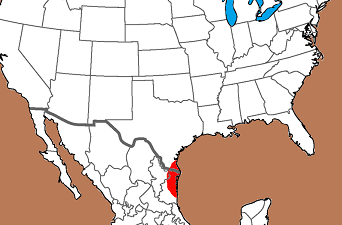Outline is Representative of Size and Shape:

Name Details:
Identified By: Richard "Scotty" MacNeish
Named For: Cameron County, Texas where the type is most prevalent.
Date Identified: 1958
Type Site: Multiple sites in Cameron County, Tx
Identified By: Richard "Scotty" MacNeish
Named For: Cameron County, Texas where the type is most prevalent.
Date Identified: 1958
Type Site: Multiple sites in Cameron County, Tx
Point Validity:
Valid type
MacNeish was a pioneering anthropologist who was most notable for his excavations and studies at Tamaulipas Mexico. This type has been references in professional publications and is considered a valid type
MacNeish was a pioneering anthropologist who was most notable for his excavations and studies at Tamaulipas Mexico. This type has been references in professional publications and is considered a valid type
Cameron Triangle
Cluster: Late Southern Triangle Cluster
Description of Physical Characteristics and Flaking Pattern:
This is a thin small equilateral triangle with a flattened cross section. The blade is excurvate. The base may vary from straight to convex with a rounded basal edge. This point has a random flaking pattern with many examples being unifacial chipped.
Size Measurements:
Total Length - 6 to 17 mm (average - 13 mm), Width - 8 to 13 mm, Thickness - 3 to 7 mm
Total Length - 6 to 17 mm (average - 13 mm), Width - 8 to 13 mm, Thickness - 3 to 7 mm
Commonly Utilized Material:
Cobbles of Edward Plateau chert. Some examples have been made from glass (Turner and Hester, 1985)
Cobbles of Edward Plateau chert. Some examples have been made from glass (Turner and Hester, 1985)
Additional Comments:
This type is similar to the Fresno point, but is slightly smaller. The Cameron point is never longer than 17 mm in length while the Fresno is not less than 20 mm in length (Moore, 2015).
Hester (1969) studies a sample of 36 samples and noted no “consistent morphological patterns” in the entire sample. Therefore, he classified those specimens that were less than 20 mm in length as Cameron and samples greater than 20 mm as Fresno. Hester believes that it is possible that both of these arbitrary groups are the same type.
Davis (1995) feels that the Cameron point may represent a continuum that includes the Matamoros and Fresno points.
This type is similar to the Fresno point, but is slightly smaller. The Cameron point is never longer than 17 mm in length while the Fresno is not less than 20 mm in length (Moore, 2015).
Hester (1969) studies a sample of 36 samples and noted no “consistent morphological patterns” in the entire sample. Therefore, he classified those specimens that were less than 20 mm in length as Cameron and samples greater than 20 mm as Fresno. Hester believes that it is possible that both of these arbitrary groups are the same type.
Davis (1995) feels that the Cameron point may represent a continuum that includes the Matamoros and Fresno points.
Distribution:

Distribution Comments:
This point is primarily found in the Rio Grande Delta and into the Baffin Bay and Corpus Christi region.
This point is primarily found in the Rio Grande Delta and into the Baffin Bay and Corpus Christi region.
Age / Periods:
Date: 800 - 250 B.P.
Cultural Period:Late Prehistoric to Historic
Glacial Period: Modern Times
Culture:
Date: 800 - 250 B.P.
Cultural Period:Late Prehistoric to Historic
Glacial Period: Modern Times
Culture:
Age Details:
Other points in this cluster / Related / Associated Points:

